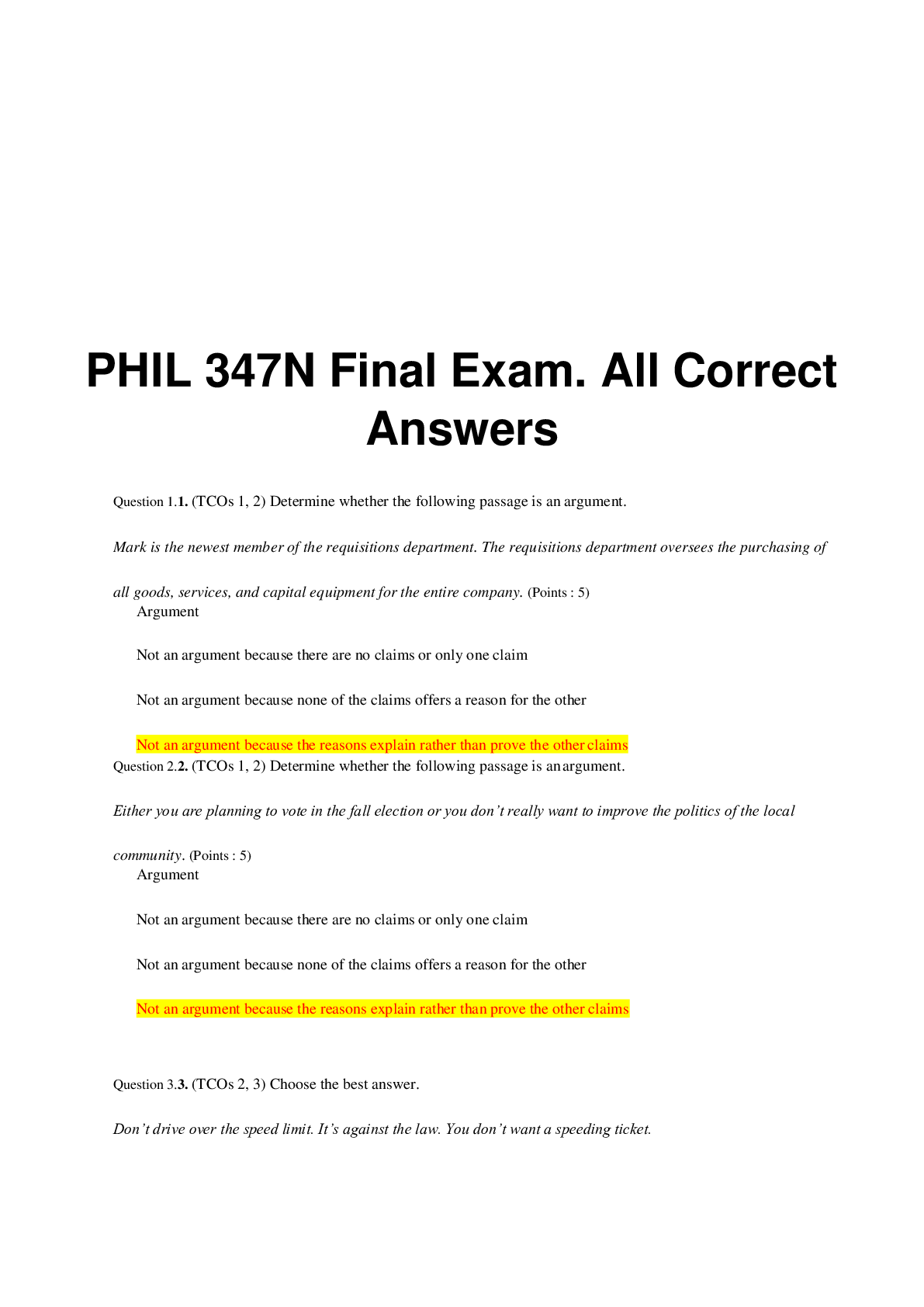Optometry > QUESTIONS & ANSWERS > NCLE Advanced Certification Exam (All)
NCLE Advanced Certification Exam
Document Content and Description Below
The answer is D. The posterior optical zone will directly affect the lens to cornea relationship of a rigid gas permeable lens. If the posterior optical zone is steepened, it will increase the sagitt... al depth. If it is flattened, it will decrease the sagittal depth. Changing the power, which is accomplished by changing the anterior optical zone, will not affect the sagittal depth of the lens, nor will changing its edge design. - ANSWER 1. The sagittal depth of a rigid gas permeable contact lens can be altered without changing the diameter by: A. Changing the power B. Changing the edge design C. Changing the radius of curvature of the anterior optical zone D. Changing the radius of curvature of the posterior optical zone The answer is A. A lens is truncated by removing a segment of the lower edge of a contact lens. This creates a straight edge that interacts with the lower lid and aids in lens positioning. Of the lens designs listed in the question, the only one that requires precise positioning of its optical portions is a translating bifocal lens. - ANSWER 2. A truncation is used on a rigid gas permeable contact lens to help enhance the performance of which type of design? A. Bifocal B. Aphakic C. Bitoric D. Keratoconus The answer is B. A lenticular or myoflange design will decrease the mass of an aphakic lens as well as increase the edge profile, which allows it to interact more with the upper lid and aid in positioning of the lens. - ANSWER 3. The mass of an aphakic rigid gas permeable contact lens can be reduced by making the lens design: A. Spherical B. Lenticular C. Tricurve D. Aspheric The answer is B. Increasing the optical zone diameter and increasing the overall lens diameter will both tighten and steepen the relationship of the lens to the cornea. Decreasing the optic zone diameter will serve to flatten and loosen the lens to cornea relationship. Using a prism-ballasted lens design will not affect the lens to cornea relationship as it relates to sagittal depth. - ANSWER 4. In order to tighten the fit of a rigid gas permeable lens you can: I. Increase the optical zone diameter 2. Decrease the optical zone diameter 3. Increase the overall lens diameter 4. Use a prism ballasted lens design A. 3 only B. 1&3 C. 2 only D. 2&3 The answer is D. A hyperflange will decrease edge thickness as well as lens awareness . Aspheric peripheral curves change the posterior design of the lens but do not reduce edge thickness. A higher Dk material will not change the overall lens edge thickness. A myoflange will actually add thickness to the lens edge and is used for high plus lenses not high minus lenses. - ANSWER 5. A high minus rigid gas permeable lens will be thin centrally with relatively thick edges. To reduce the edge thickness, and increase overall comfort, use: A. Aspheric peripheral curves B. A myoflange C. A higher Dk material D. A hyperflange The answer is C. One would rarely polish or attempt to manipulate the central posterior surface of a rigid lens. Applying polishing pressure to the mid-peripheral and the peripheral anterior surface would add plus power. Applying polishing pressure to the central anterior surface would add minus power. - ANSWER 6. To add minus power to a rigid contact lens with a rotating modifying spindle, one would: A. Polish the posterior surface of the rigid lens B. Polish the mid peripheral anterior surface C. Polish the central anterior surface D. Polish the peripheral anterior surface The answer is A. The keratometer readings indicate the need for a spherical back surface, which would rule out the use of a bitoric lens. A soft spherical lens would not correct the moderate amount of refractive astigmatism that is present, nor would the spherical rigid gas permeable lens. A front surface toric RGP would best meet this patient's needs since it has a spherical back surface, but has a toric front surface which would correct the residual astigmatism. - ANSWER 7. Which lens design would provide the best visual acuity for a patient with the following information? K's 42.00@ 180/ 42.50@90 Rx -6.75 +1.75 cx 90 A. Front surface toric rigid gas permeable B. Spherical rigid gas permeable C. Soft sphere D. Bitoric rigid gas permeable The answer is A. The wetting angle of a rigid gas permeable material describes how a fluid spreads over the surface. It is important to remember, however, that wetting angle is a description of the material outside of the patient's natural ocular environment. Within minutes of insertion, a rigid lens is encapsulated in the natural tear mucin and the wetting angle of the material is no longer important. - ANSWER 8. Which of the following describes the angle that the edge of a bead of water makes with the surface of a plastic? A. Wetting angle B. Surface angle C. Bead angle D. Reflection angle The answer is B. [Show More]
Last updated: 2 years ago
Preview 1 out of 153 pages

Buy this document to get the full access instantly
Instant Download Access after purchase
Buy NowInstant download
We Accept:

Reviews( 0 )
$10.00
Can't find what you want? Try our AI powered Search
Document information
Connected school, study & course
About the document
Uploaded On
Jul 23, 2022
Number of pages
153
Written in
Additional information
This document has been written for:
Uploaded
Jul 23, 2022
Downloads
0
Views
121
























